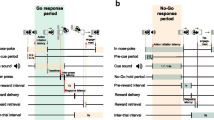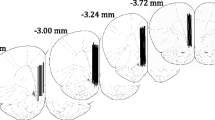Abstract
Rationale
Recent experimental findings suggest that a core cognitive deficit of schizophrenia is the degraded ability to use task-setting cues to guide goal-directed behaviour, that this deficit is evident in acute as well as chronic schizophrenia, and that such deficits can me modelled in animals using conditional discrimination tasks.
Objective
To establish the reversal potential of D1, D2 and 5-HT receptor antagonists acutely, and D1 and D2 receptor antagonists chronically, on d-amphetamine-induced disruption of a conditional discrimination task that depends on the ability to use task-setting cues to direct goal directed performance.
Method
A conditional discrimination paradigm was employed in which rats learned to respond on an appropriate lever, conditional upon specific auditory stimuli.
Results
d-Amphetamine (1.5 mg/kg) disruption of conditional discrimination was attenuated by acute pre-treatment with the selective D1 antagonist SCH 23390 and the atypical anti-psychotic clozapine (Cloz). Acute pre-treatment with the selective D2 antagonist eticlopride (Eti) and the anti-psychotic haloperidol (Hal) failed to reverse d-amphetamine disruption, as did pre-treatment with the selective 5HT1A antagonist WAY 100635 and the selective 5HT2A/C antagonist ritanserin. However, Eti and Hal did reverse d-amphetamine-induced task disruption when administered chronically (as did SCH 23390, α-flupenthixol and Cloz).
Conclusions
These results suggest that D1 receptors are involved in tasks that require the use of conditional relationships and that D2 receptor antagonism can come to exert a similar influence after chronic treatment.


Similar content being viewed by others
References
Andersen PH, Nielsen EB, Gronvald FC, Braestrup C (1986) Some atypical neuroleptics inhibit [3-H] SCH 23390 binding in vivo. Eur J Pharmacol 120:143–144
Blaha CD, Lane RF (1987) Chronic treatment with classical and atypical antipsychotic drugs differentially decreases dopamine release in striatum and nucleus accumbens in vivo. Neurosci Lett 78:199–204
Blyler CR, Gold JM (2000) Cognitive effects of typical antipsychotic treatment: another look. In: Sharma T, Harvey P (eds) Cognition in schizophrenia: impairments, importance and treatment strategies. Oxford University Press, New York, pp 241–265
Chiodo LA, Bunney SB (1985) Possible mechanisms by which repeated clozapine administration differentially affects the activity of two subpopulation of midbrain dopamine neurons. J Neurosci 5:2539–2544
Cohen JD, Servan-Schreiber D (1992) Context, cortex and dopamine: a connectionist approach to behavior and biology in schizophrenia. Psychol Rev 99:45–77
Cohen JD, Servan-Schreiber D, Steingard S (1995) Schizophrenic deficits in the processing of context: a test of neural network simulations of cognitive functioning in schizophrenia. Schizophr Res 15(1–2):113
Dunn MJ, Futter D, Bonardi C, Killcross AS (2005) Attenuation of d-amphetamine-induced disruption of conditional discrimination performance by α-flupenthixol. Psychopharmacology (Berl) 177:296–306
Earle-Boyer EA, Serper MR, Davidson M, Harvey PD (1991) Continuous performance tests in schizophrenic patients: stimulus and medication effects on performance. Psychiatry Res 37:47–56
Farde L, Halldin C, Stone-Elander S, Sedvall G (1987) PET analysis of human dopamine receptor subtypes using 11C-SCH 23390 and 11C-raclopride. Psychopharmacology (Berl) 92:278–284
Farde L, Nordstrom AL, Wiesel FA et al (1992) Positron emission tomographic analysis of central D1 and D2 receptor occupancy in patients treated with classical neuroleptics and clozapine: relation to extrapyramidal side-effects. Arch Gen Psychiatry 49:538–544
Gerlach J, Andersen J, Clemmensen L, Haffner F, Lublin H (1994) Antipsychotic efficacy of D1 receptor antagonists evaluated in primates (NNC 01-0756) and in a phase II clinical study (NNC 01-0687). Neuropsychopharmacology 10:237S
Goldman-Rakic PS (1995) Psychopathology and neuropathology of prefrontal cortex in schizophrenia. In: Fog R, Gerlach J, Hemmingsen R (eds) Schizophrenia. Munksgaard, Copenhagen, Denmark, pp 126–136
Goldman-Rakic PS (1999) The relevance of the dopamine-D1 receptor in the cognitive symptoms of schizophrenia. Neuropsychopharmacology 21:171–180
Granon S, Passetti F, Thomas KL, Dalley JW, Everitt BJ, Robbins TW (2000) Enhanced and impaired attentional performance after infusion of D1 dopaminergic receptor agents into rat prefrontal cortex. J Neurosci 20:1208–1215
Hess EJ, Bracha HS, Kleinman JE, Creese I (1987) Dopamine receptor subtype imbalance in schizophrenia. Life Sci 40:1487–1497
Karle J, Clemmensen L, Hansen L, Anderson M, Anderson J, Fensbo C, SlothNielsen, M, Skrumsager B, Lublin H, Gerlach J (1995) NNC 01-0687, a selective dopamine D1 receptor antagonist, in the treatment of schizophrenia. Psychopharmacology (Berl) 121:328–330
Knable MB, Hyde TM, Egan MF, Tosayali M, Wyatt RJ, Kleinman JE (1994) Quantitative autoradiography of striatal dopamine D1, D2 and re-uptake sites in rats with vacuous chewing movements. Brain Res 646:217–222
Kohler C, Haglund L, Ogren SO, Angeby T (1981) Regional blockade by neuroleptic drugs of in vivo 3H-spiperone binding in the rat brain. Relation to blockade of apomorphine induced hyperactivity and stereotypes. J Neural Transm 52:163–173
Laruelle M, Jaskiw GE, Lipska BK, Kolachana B, Casanova MF, Kleinman JE, Weinberger DR (1992) D1 and D2 receptor modulation in rat striatum and nucleus accumbens after subchronic and chronic haloperidol treatment. Brain Res 575:47–56
Lidow MS, Goldman-Rakic PS (1994) A common action of clozapine, haloperidol, and remoxipride on D1- and D2-dopaminergic receptors in the primate cerebral cortex. Proc Natl Acad Sci U S A 91:4353–4356
Okubo Y, Suhara T, Suzuki K et al (1997) Decreased prefrontal dopamine D1 receptors in schizophrenia revealed by PET. Nature 385:634–637
Raiteri M, Bertollini A, Francesco F, Levi G (1975) d-Amphetamine as a releaser or uptake inhibitor of biogenic amines in synaptosomes. Eur J Pharmacol 34:189–195
Sedvall GC, Karlsson P (1999) Pharmacological manipulation of D1-dopamine receptor function in schizophrenia. Neuropsychopharmacology 21:181–188
Serper MR, Bergman RL, Harvey PD (1990) Medication may be required for the development of automatic information processing in schizophrenia. Psychiatry Res 32:281–288
Servan-Schreiber D, Cohen JD, Steingard S (1996) Schizophrenic deficit in the processing of context. Arch Gen Psychiatry 53:1105–1112
Sparber SB, Tilson HA (1972) The releasability of central norepinephrine and serotonin by peripherally administered d-amphetamine before and after tolerance. Life Sci 11:1059–1067
Stewart J, Vezina P (1989) Microinjections of SCH 23390 into the ventral tegmental area and substantia nigra pars reticulata attenuate the development of sensitisation to the locomotor activating effects of systemic amphetamine. Brain Res 495:401–406
Stratta P, Daneluzzo E, Bustini M, Prosperini P, Rossi A (2000) Processing of context in schizophrenia: relation to clinical symptoms and WCST performance. Schizophr Res 44:57–67
Suhara T, Kobayashi K, Sudo Y, Suzuki K, Inoue, O, Tateno Y, Okub Y, Terasaki, O, Someya Y, Sassa T, Toru M (1996) Pet studies of D1 and D2 dopamine receptors in schizophrenia patients. Eur Neuropsychopharmacol 6:73
Waddington JL (2000) New antipsychotic drugs: preclinical and clinical profiles in the treatment of schizophrenia In: Reveley MA, Deakin JF (eds) The psychopharmacology of schizophrenia. Arnold, London
Zetterstrom T, Sharp T, Ungerstedt U (1984) Effect of neuroleptic drugs on striatal dopamine release and metabolism in the awake rat studied by intracerebral dialysis. Eur J Pharmacol 106:27–37
Acknowledgements
This research was supported by a BBSRC Research Committee Studentship to Michael Dunn and by an Independent Investigator grant from the National Alliance for Research on Schizophrenia and Depression (2001 Zarrow Investigator) to Simon Killcross.
Author information
Authors and Affiliations
Corresponding author
Rights and permissions
About this article
Cite this article
Dunn, M.J., Killcross, S. Differential attenuation of d-amphetamine-induced disruption of conditional discrimination performance by dopamine and serotonin antagonists. Psychopharmacology 188, 183–192 (2006). https://doi.org/10.1007/s00213-006-0488-y
Received:
Accepted:
Published:
Issue Date:
DOI: https://doi.org/10.1007/s00213-006-0488-y




